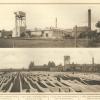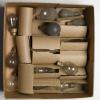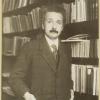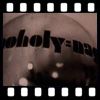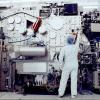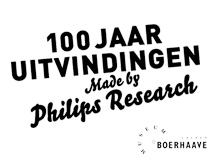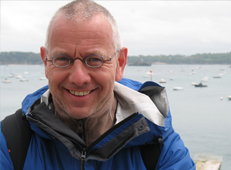Between Brussels and Shanghai: Industry, technology, and arts
Lásló Moholy-Nagy-Lichtspiel Schwarz-Weiss-Grau, 1933
Eindhoven became a place where artists, entrepreneurs, and designers from Europe and beyond connected technology and industry with design and arts.
In 1936, Henri van Abbe, a wealthy entrepreneur who earned his fortune in the city’s cigar industry, opened the Van Abbe Museum. In 1971, the museum obtained a replica of László Moholy-Nagy’s Licht-Raum Modulator. The Hungarian artist, who was also a teacher at the famous German Bauhaus, designed the apparatus in the 1920s for theatrical, marketing, and even radio transmitting purposes. By connecting these functions to an object of art, Moholy-Nagy was way ahead of his time.
So was Philips, which combined music, architecture, and design in a Gesamtkunstwerk at the 1958 World Expo in Brussels. The Poème électronique was a multi-media showpiece with electronic music accompanying wall projections in a futuristic building designed by the Greek architect and composer Iannis Xenakis and the French architect Le Corbusier.
In 2005, the British magazine Icon ranked the Design Academy Eindhoven amongst the world’s top five most influential institutions, persons, and objects in design. The 2010 World Expo in Shanghai featured ‘Happy Street’, an architectural piece of art by Dutch artist John Körmeling, who lives and works in Eindhoven.
Eindhoven has a longstanding and successful tradition of connecting technology, design, and art. The question is whether the city can further develop this quality and become an international hub in this fusion of creativity and knowledge.
 Previous Story
Next Story
Previous Story
Next Story
How to cite this page
Eric Berkers, 'Between Brussels and Shanghai: Industry, technology, and arts ', Inventing Europe, http://www.inventingeurope.eu/philips/between-brussels-and-shanghai-industry-technology-and-arts
Sources
- Bergdoll, B. and L. Dickerman, Bauhaus 1919-1933. Workshops for Modernity. New York: Museum of Modern Art, 2009.
- Weitemeier, H. Licht-Visionen. Ein experiment von Moholy-Nagy. Berlin: Bauhaus-Archiv, 1972.
- Caton, J. Harris. The Utopian Vision of Moholy-Nagy. Ann-Arber: UMI Research Press, 1984.
- Make it new. Le poème électrique. Onderzoek voor de reconstructie van het Philips-paviljoen uit 1958 in Eindhoven, edited by H. le Blanc and others. Eindhoven: Stichting Alice, 2006.
- Treib, M. Space calculated in seconds. The Philips Pavilion, Le Corbusier, Edgard Varèse. Princeton: Princeton University Press, 1996.
- Kalff, L., W. Tak en S. de Bruin. “Verwezenlijking van het “Elektronisch gedicht” in het Philipspaviljoen op de Wereldtentoonstelling te Brussel.” Philips Technisch Tijdschrift 20, no. 6/7 (1958): 161-174.
- “The architectural design of Le Corbusier and Xenakis.” Philips Technical Review 20, no.1 (1958/1959).
- “21 Most Influential.” ICON Magazine Online, (March 2005). Accessed March 2013. http://www.iconeye.com/read-previous-issues/icon-021-%7C-march-2005/21-most-influential-%7C-icon-021-%7C-march-2005





